Work on land, essential
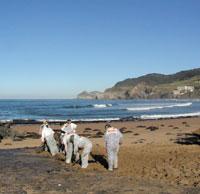
The Cantabrian coast has a better appearance than a few months ago, since on the surface of the sea there is no longer a large layer of chocolate mousse. However, from a close point of view, fuel remains are quickly detected. Taking into account the proximity of summer and the importance of tourism, the most effective and suitable method to clean the coast is being sought. The preferences of authorities and scientists do not always coincide.
However, everyone is clear that you cannot leave all the cleanliness in the hands of nature. Before people thought that nature had an unlimited capacity for renewal and quietly poured its waste into the sea, hoping that eventually the sea itself would destroy them. If the sea is indeed able to degrade waste, but only in part, such a spill exceeds that capacity.
Previous disasters have shown that a cleaning effort must be made. In 1974, in the Strait of Magellan, the oil tanker Metula emitted 50,000 tons of fuel, in which there was a very abrupt sea and no one lived, nothing was done to clean the spill. Since then almost thirty years have passed and the rocks are still paved.
What situation, a solution
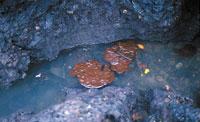
The fuel dumped by the Prestige is also slowly degraded and the Cantabrian coast cannot be maintained, cleaning is necessary. However, the limit between the benefits of fuel withdrawal and the damage from cleaning operations is very weak in some places. In some previous disasters, harsh cleaning methods were used, and then the consequences have been seen: these treatments were more harmful in the long run than fuel.
Despite the use of gentle methods, it is advisable that only experts participate in some places. For example, marshes, dune beaches or low levels of the intertidal area are very vulnerable, so caution should be taken at work because otherwise it is easy to prevent it from benefiting and damage occurs.
Proper planning and coordination of cleaning tasks is essential to minimize the environmental condition. To begin with, it is important to know how fuel is, since when choosing cleaning methods it also has influence. In this case, the Prestige fuel has few soluble and volatile compounds, so it can be assumed that almost everything that has been poured before or after will reach the coast.
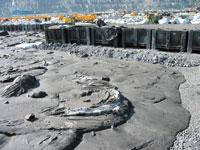
On the other hand, the fuel that comes immediately after the spill is different from the one that arrives in a time. The situation worsens over time: fuel captures water, emulsifies and its volume doubles or triples. Finally, the fuel can contain between 60% and 70% of water. The problem is that it is much more viscous and sticky than the initial fuel.
Later, after a long time of fuel in the sea, tar balls appear. Due to waves and currents, large initial stains are fragmented, volatile compounds are lost and the top layer hardens. Thus tar balls are formed. They are less sticky than fuel emulsion and are collected relatively easily on the coast, but they are very persistent.
The best, hand and gently
On the bank of the Cantabrian, cleaning work is carried out mainly manually, not only because sometimes there is no alternative, but because it is the best option. However, there are areas where you choose not to act: very dangerous areas for working people, areas where cleaning is more harmful than beneficial, cliffs where waves clean very well...
In most other places, the best cleaning method is the manual collection of the fuel by means of shovels, rakes, brushes, levers, etc.
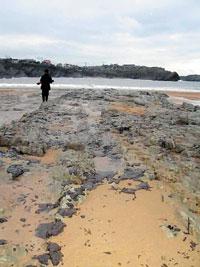
Manual cleaning is very suitable if pollution is low or medium and if done well the risk of environmental condition is really low. The greatest risk is to clean it with “too much desire” and extract algae and attached organisms, for example. In addition, we must foresee where to collect the waste and why way, to avoid contaminating what was previously clean.
Absorbent materials, such as polypropylene fibers, sawdust, straw, etc., are appropriate in some places, such as rock stretch wells. This method does not cause any damage, but it does not serve to collect tar balls when the fuel is very viscous. Vacuum cleaners can be used in higher-fuel wells. However, as with materials that absorb oil, fuel must be liquid and most of the fuel is already reinforced.
In areas with a lot of fuel, rocks with large stones, buildings or when it is not possible to reach the place where the fuel is located, low pressure hoses are used. Water pressure should be less than 10 psi and join a detached fuel collection system. In addition, to avoid damage to communities located at low level or in sediments, it is sometimes advisable to use hoses when the tide is above.
Previous experiences, lessons
High pressure hoses are only recommended in buildings and in some rocks that do not reach the tide. In the Exxon Valdez spill in Alaska in 1989 high-pressure water jets were used for cleaning some areas. These places took longer to recover than those maintained. Therefore, now this method is only used in malecones, springs, etc.
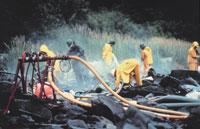
Although it has generally been proven that manual cleaning is the most appropriate, a large machinery has also been used in certain areas, as is the case of the beach of San Lorenzo de Gijón. The floor of this beach is very compact and the black tide came to it for a few days. The excavators were then used. In other cases, on beaches with low compacted sediments or with scattered fuel spots, machinery is not recommended in any case.
At first, in Galicia there was more than one who asked for the entry of large machines, which did not believe that manual cleaning would be enough. However, using machines can cause huge damage: In 1978, the oil tanker Amoco Cádiz issued 250,000 tons of fuel in France, in front of Brittany. There, as here, there were many people who lived from the sea and worked hard to remove the fuel. For the cleaning of the rías large machinery was introduced and half a meter of the bottom sediment was removed. At present these places have not been recovered.
What happened in previous catastrophes has been decisive in deciding what measures to take.
But that's not enough. Experts report that there is not enough scientific research in these cases, so it is not possible to make decisions based on scientific results. Therefore, to know how to act it is essential to conduct long-term research. Because science has to say.
Clean the coast: What is the priority?
The Prestige fuel has been the daily motto of last winter: it is pouring so much per day, Nautile has covered so many holes, so many tons have been collected on the beaches, so many fishermen at sea. Immediately the need to collect fuel at sea was detected to prevent the arrival of the spill to the coast. It is clear that the effort made in this area in the Autonomous Community of the Basque Country has had a very positive, eliminable result. Otherwise, unfortunately, we have walked in parallel.
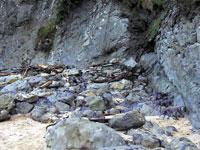
On our beaches there is little to “save”, unfortunately and with exceptions. The natural and ecological values best preserved on our coast present rocky coasts. The institutional commission created for the management of the crisis, driven by environmental and naturalistic groups, approved quite quickly the protocol of cleaning rocks, but its application has not been prioritized by crisis experts Erika and Exxon Valdez. The presence of rocks is also at risk, and the validity of cleaning methods is unclear. In addition, clean up such an expensive coastal area and quickly get dirty again... No. He postponed.
Meanwhile, rock fuel has begun to move and change. Previously solidified resistant fuel spots, softened by the sun, begin to slide into unstained areas. Others have been covered by the movement of stones. Others are separated by waves of rocks and scattered along the coast. That is, unforeseen events begin to happen. The unprioritized cleaning seems to be finally undertaken.
But in the meantime, the cycles of nature have advanced, as every year. The hawks and whalers of the coast are engaged in breeding since January, almost the same number of white owls and ropes. Now it's up to seagulls and sero: For San Prudencio there will be new roasted eggs in the breeding colonies, and chickens that do not know how to fly will be to the area of San Ignacio, under the threat of anyone. The cleaning brigades are not thinking about entering NOW, right? Or if you send San Turismo?
Related information
Where to wash? The preferred location should be defined before cleaning. Not only is the degree of contamination taken into account, but other aspects are also considered. On the one hand, places of high ecological value should be the first to be cleaned, as they threaten the inhabitants and their descendants. On the other hand, the socio-economic aspect is also seen, since there are many people from the coast who live from seafood nurseries and tourist beaches. In the end, however, the practical aspect is decisive, partly it is planned based on the money available. |
Buletina
Bidali zure helbide elektronikoa eta jaso asteroko buletina zure sarrera-ontzian











